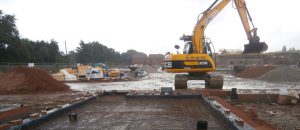Conder Allslade – Building Quality with Steel (The Following is a Promoted Article) Steel continues to be the choice material in the construction industry, favoured for its sustainability, durability, versatility and affordability. Operating by those very same tokens, Conder Allslade has secured a resolute identity in the structural steel sector, and is continually favoured by clients for its high quality, comprising service. Following its establishment in 2008, Conder Allslade has solidified its reputation in the steel construction industry, fast-becoming a leader in the provision of high quality structural steel and now equipped to carry out both design-and-build and consultant-designed projects. With its network of regular partners and sub-contractors, the company realises itself much like a one-stop-shop in structural steelwork and continues to add further capabilities under its structural steel header. It’s with such a comprehensive service that the company finds itself working within multiple sectors, including: warehouse and industrial distribution, manufacturing, commercial, offices, town centres, car parks, cinemas, retail facilities, leisure centres, education and health. Inundated with a variety of projects though Conder Allslade may be, its focus on quality has yet to wane and the company prides itself on its ability to work exactly to individual clients’ needs. “We like to think we work with our clients rather than simply for them,” Mike Hunter, Managing Director of Conder Allslade insists. “We work across a variety of projects and, within that, undertake new builds, extensions and refurbishments. Whether we’re approached at a design, manufacture or erection stage, we strive offer superior, integrated customer service and support at all times so as to offer something which is tailored exactly to a customer’s brief.” Whilst each of the projects on which the company works necessitate a different approach and bear distinct challenges, Conder Allslade’s distinct hallmark of quality is consistent throughout. Having invested in a state-of-the-art processing facility, the company is now able to carry out shot-blasting, sawing, drilling and robotic profiling – each to CE Mark EX3. Now with over 15,000 square metres of production facilities, the company is well-equipped offer its customers maximum quality and flexibility in the manufacture of high quality structural steelwork and complex components. Cutting edge technology aside, the quality and accuracy of its steel is largely attributable to Conder Allslade’s highly-qualified manufacturing team who, followed up by dedicated inspections, enact various quality control measures before, during and after production. In view of the crucial role its staff play when securing contracts and carving out a unique identity in the sector, Conder Allslade has devoted real time and attention to its operatives, sourcing the best in the sector as well as providing opportunities for training and development so as to safeguard the quality of work carried out. “We tend to employ full tradespeople,” details Hunter, “And find that they come with a certain assurance in quality because of the breadth of experience they have in complex manufacture and precision engineering, rather than being purely single discipline specialists. We make sure everyone has that adaptability; our operatives are trained to both plate and weld so they do the whole job on the bar, they put the whole assembly together.” Emphasis on existing staff aside, there is the added pressure of securing a future workforce for which training and development simply will not do. It’s been widely reported that there is declining interest amongst younger generations in manufacturing and engineering industry and fewer and fewer people are going on to pursue a career in the sector. It’s resulted in a lack of specialist tradespeople and concern for the national face of the industry. With expressed determination to secure the future of the sector and its own esteem within that, the company has acknowledged those skills shortages threatening the sector and actively sought to address the deficits in technical expertise by engaging with local apprenticeship schemes. Hunter details further: “We engage with local colleges and have supported two apprentices through to NVQ Level 3 in the last five years. More than just a box-ticking exercise, apprentices are trained in other areas of the business; in particular, aspects related to shop-floor operation. With the additional opportunity to work with our Maintenance Engineer, they become multi-skilled engineers capable of getting the best out of the kit, and doing so in the safest possible way.” The two apprentices have since qualified as platers, and are employed full-time by the company. At each level of employment, staff benefit from the ability to train and work in multiple areas and thus gain insight and experience within a number of discrete but inter-related disciplines. Indeed, the company’s versatility can be attributed to the cross-pollination of practices and processes that occurs during its keen training and development schemes. A recent project for the Farnborough International Airshow (FIA) made use of Conder Allslade’s flexible and all-encompassing structural steel service. It saw the company provide the entire superstructure, from the steelwork to the floor, and from the cladding to each window and door. Whilst the company has gone on to establish itself in a number of different aspects of steel manufacture and construction, Conder Allslade’s unique, end-to-end service is only made possible through the partnerships it sustains with sub-contractors and suppliers. After design and fabrication, the company utilises the services of fellow steel specialists for management and erection, and its role becomes that of ensuring all interfaces between trades are covered. Collaboration between itself and subcontractors inevitably throws up challenges to health and safety, as well as threatening lapses in either schedule or quality. With an ingrained health and safety culture, Conder Allslade refuses to tolerate anyone flouting the rules and retains a strict code of conduct by which partners must abide. Subcontractors must complete a health and safety questionnaire as part of the approval process in which they must detail their safety performance, competence, training, insurance and other issues. Risk to health and safety is taken incredibly seriously, as Hunter continues: “All our supervisors have gone through either the Site Supervisor Safety Training Scheme (SSSTS) or the





